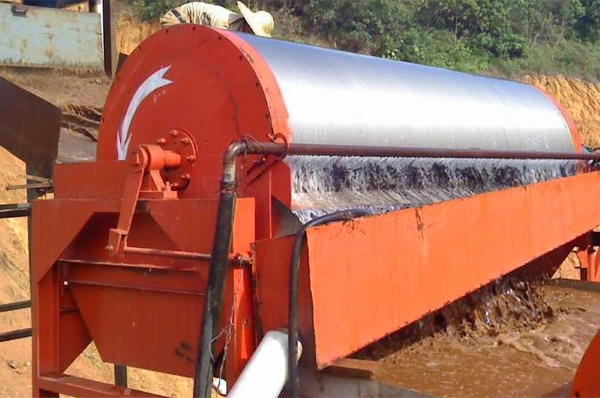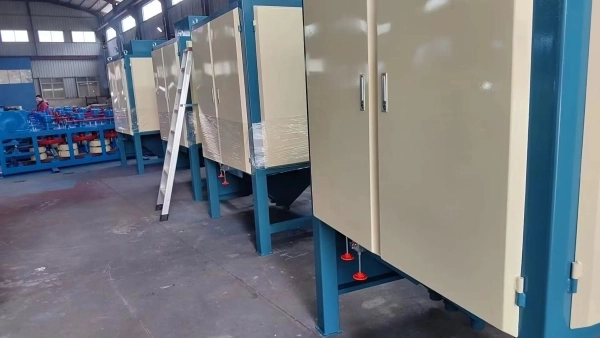Gravity separation and magnetic separationare two most common beneficiation methods for chrome ore, but the magnetic separation effect of the South African chrome ore is poor, and the grade of the magnetic separation concentrate varies greatly. To this problem, we have carried out a detailed study on the properties of chrome ore.

The results show that the useful component in the ore is 34.25% Cr2O3. and the chrome-containing minerals are mainly hard chromium spinel. The main reason that affects the magnetic separation effect is that the hard chrome spinel in the chrome ore is non-magnetic, and the magnetic separation effect is not ideal.
01 Chrome Ore Material Composition
We first selected a representative ore, and then performed multi-element analysis and mineral composition analysis on the sample.
(1) Ore chemical multi-element analysis
The main chemical analysis results of the ore are shown in Table 1. It can be seen from Table 1 that the useful element in the ore is chrome.

(Table 1 Main chemical composition analysis results of the ore)
(2) Analysis of ore mineral composition content
The samples in the dressing plant are all broken fragments, most of which have a particle size of 1 cm, and about 5.000g of samples are collected. After the samples are mixed evenly, the samples are prepared and ground into 10 light slices and 5 thin slices for observation and research under the microscope.
Through the analysis and identification of light slices and thin slices under the microscope, scanning electron microscope and energy spectrum analysis, the mineral composition of the ore is relatively simple, the useful mineral is hard chrome spinel, and the metal mineral composition is chalcopyrite, pyrite, vanadium-containing titanium magnetite. The gangue mineral components are pyroxene, plagioclase, biotite and so on.
02 Chrome Ore Structure
There are 7 characteristics in the structure of chrome ore.
(1) Granular structure
Hard chrome spinel is granular, some of which are coarse, up to several millimeters. Hunger titanium magnetite is granular.
(2) Package structure
Coarse pyroxene particles are wrapped with granular hard lead spinels of different sizes. Some of the hard chrome spinels are covered with acicular rutile inclusions. There are densely distributed acicular rutile inclusions in pyroxene. Pyroxene contains starved titanium-magnetite inclusions. There are small chalcopyrite inclusions in the quartz.
(3) Autohedral, semi-autohedral crystal structure
Some hard chrome spinels are euhedral and semi-euhedral crystals with straight boundaries and perfect crystal shapes. Some pyroxenes are semi-euhedral columnar in shape.
(4) Alternate structure
The hard chromium spinel is metasomatized by quartz, and the quartz is distributed in the hard chromium spinel in the form of network veins, and the hard chromium spinel can be seen locally as island-like metasomatization residues. Biotite is replaced by chlorite. The cut surface of plagioclase is cloudy and clay-like.
(5) Crystal structure
Parts of pyroxene and plagioclase have an allomorphic crystal structure.
(6) Scale-like structure
Biotite, talc, and chlorite are aggregated and distributed in scale-like aggregates.
(7) Fragmentation structure
Part of the hard chromium spinel grains are obviously broken inside or at the edge.
03 Main Features of Chrome Ore
There are four main minerals in chrome ore, namely hard chrome spinel, rutile, vanadium-containing titanomagnetite and pyroxene.
(1) Hard chrome spinel
The spinel minerals are isomorphic and have relatively complex components. All chrome minerals with industrial value belong to lead spinel minerals. The general chemical formula of spinel is (MgFe2+)(CrAlFe3+)2O4. In spinel, there is a wide range of isomorphism between Mg and ferrous iron, Cr, Al and ferric iron substitute. Chromium spinel minerals are composed of 5 basic components, so the content of each component varies greatly, and its chromium oxide content varies from 18% to 62%.
Most of the hard chrome spinel is in the form of monomer dissociation, and a small part is in the form of conjoined bodies. Hard chrome spinel is mostly conjoined with pyroxene, and part of pyroxene is in the form of coarse columnar particles, which are wrapped with hard chrome spinel of different sizes. A few hard chrome spinels grow contiguously with quartz and are replaced by quartz, leaving hard chrome spinel in the shape of silkworm erosion. Some hard chromium spinels have acicular and plate-like rutile (or chromium-iron rutile) inclusions, and rutile (or diamond-containing rutile) is sparsely or densely distributed in hard chromium spinel. This kind of rutile is difficult to compare with hard chromium spinel dissociation
Hard chrome spinel energy spectrum analysis result shows that, the content of chromium in the hard chrome spinel changes little, is 27.85%~35.69% the content of iron is 19.18%~30.39%, the change of iron content will be Affects the magnetic strength of hard chromium spinel, and there is no obvious correlation between changes in iron and chromium content; most hard-filled spinel contains carbon and titanium, of which the carbon content can reach up to 5.63%, and the titanium content is low , mostly less than 1% impurity elements affect the grade of chromium ore concentrate.
(2) Rutile
Rutile (TiO2) is a tetragonal mineral, columnar or needle-like crystals, pure rutile is almost all TiO2. often with iron, tin, chromium, vanadium, tantalum, niobium and other isomorphic mixtures.
The rutile energy spectrum analysis result shows, does not contain chromium in the individual rutile, contains compositions such as chrome, iron and titanium in the part rutile, should be chromium-containing iron rutile, and the content of chrome in the rutile changes greatly, is 10.88%~20.40%. The iron content is 5.93%~12.97%.
(3) Vanadium-containing titanium magnetite
Vanadium-containing titanomagnetite (Fe2+Fe3+TiV)2O4 is a kind of ore containing multi-metal elements. It is a magnetite containing vanadium and titanium. Vanadium, titanium and iron exist in the in magnetite.
Vanadium-containing titano-magnetite energy spectrum analysis results show that the vanadium-containing titano-magnetite contains components such as vanadium, vanadium and titanium, and the change in titanium content is 3.24%~7.22%; the change in vanadium content is 0.34%~0.5%; titanium content change is 12. 63% ~ 20. 15%
(4) Pyroxene
Pyroxene has a high content in ore and is the main gangue mineral. Pyroxene has a semi-euhedral columnar shape, often wrapping hard chromium spinel, and is very closely related to hard chromium spinel.
The results of energy spectrum analysis of pyroxene show that a small amount of chromium and titanium are mixed in individual pyroxene, and the content of titanium and lead is relatively low.
04 Analysis of the Occurrence State of Hard Chrome Spinel
Under the microscope, it can be seen that the hard chrome spinel particles are relatively coarse, up to several millimeters, which is beneficial for sorting. Most of the hard chromium spinel has been dissociated as a single body, and a small part is in the form of conjoined bodies. Some hard lead spinel particles develop internal cracks, which are easy to dissociate.
(1) Particle size analysis of hard chrome spinel
Mineral intercalation particle size is an important factor affecting the determination of the beneficiation process and the selection index. The largest hard chrome spinel particle size found under the microscope is 2. 2 mm, and the smallest particle size is 0. 01 mm. Hard chromium spinel particles with a size larger than 0.074 mm accounted for 58.6%, and particles larger than 0.043 mm accounted for 75.79%.
(2) Analysis of hard chromium spinel embedding state
Most of the hard chromium spinel in the sample is dissociated, only a small part is associated with pyroxene or wrapped by pyroxene.
The dissociation state of hard chrome spinel is dominated by monomers, accounting for 75%, and associated growths account for 25%, mainly associated with pyroxene, and individual particles are associated with plagioclase, quartz, etc.
05 Mineralogical Factors Affecting Hard Chrome Spinel Extraction
This ore belongs to hard chrome spinel of basic magmatic origin, with simple mineral composition and single structure.
(1) The content of Fe in the ore
The results of scanning electron microscopy show that the internal composition of hard chrome spinel is relatively complex, the isomorphic substitution is obvious, and the content of iron, magnesium, aluminum and chromium varies greatly. In particular, changes in the iron content will affect the magnetic strength of hard chrome spinel.
(2) The presence of associated vanadium titanomagnetite
The energy spectrum analysis results of a small amount of vanadium-containing titano-magnetite show that it contains vanadium, titanium, titanium and other components. When the content of the associated vanadium-containing titano-magnetite reaches the recycling standard, it can be comprehensively recycled.
(3) The influence of gangue minerals
Gangue minerals such as hard chromium spinel and pyroxene grow together, and part of hard chromium spinel is distributed in pyroxene in the state of inclusions, which affects the recovery rate; part of hard lead spinel contains rutile small inclusions, rutile The inclusions affect the sorting effect of hard chrome spinel and also affect the grade of concentrate.
Through the above analysis of the mineralogical factors that affect the hard chrome spinel separation index, we can know that there are three main reasons for the poor separation effect of the South African chrome ore magnetic separation plant:
The quality of raw ore changes greatly, and the content of hard chrome spinel and vanadium-containing titanium magnetite changes greatly;
Chrome spinel is a weak magnetic mineral, and the content of iron in it will affect the magnetic strength of hard chrome spinel. In the results of energy spectrum analysis, the iron content of hard lead spinel varies greatly, and the magnetic properties of hard chromium spinel will also be affected. The product of strong magnetic separation in the concentrator should be vanadium-containing titanium-magnetite;
The influence of conjoined bodies, some vanadium-containing titanium-magnetite and hard chromium spinel are conjoined, which affects the separation effect.
06To Wrap Up
The South African chrome ore is relatively simple in composition, the valuable component Cr2O3 in the ore, the grade is 34.25%, and the target mineral is hard chrome spinel.
The contact boundary between hard chromium spinel and gangue minerals is flat, which is easy for monomer dissociation. Although part of the pyroxene is wrapped with hard chromium spinel particles, the cleavage of pyroxene is developed and it is easy to separate from the hard chromium spinel. Part of the hard chromium spinel is wrapped with small rutile inclusions, but the rutile particle size is small and the content is low, which has little impact on the quality of the concentrate.
From the results of mineral composition and energy spectrum analysis, magnetic separation is not an effective beneficiation process. It is recommended to enrich the hard chromium spinel by gravity selection. Vanadium-containing titano-magnetite and hard chromium spinel are separated by magnetic separation, and the vanadium-containing titano-magnetite can be comprehensively recovered without increasing the cost of mineral processing.
If you want to customize a chrome ore separation solution, please leave a message or chat with the online service, and we will contact you soon.
- Random article
- Popular articles
- Popular comments
- Gravity combined beneficiation process for black and white tungsten ore
- Branch serial flow flotation process for lead-zinc ore
- Sulfide Ore Nickel Ore Mixed Flotation Process
- Laterite Nickel Ore Hydrometallurgical Process for Oxide Ore
- Radioactive beneficiation and flotation process for uranium ore
- Zirconium Ore Processing: Gravity, Magnetic, and Electric Separation
- Zirconium Ore Processing: Gravity, Magnetic, and Flotation Methods










Leave a message with your needs or comments
Add comment: